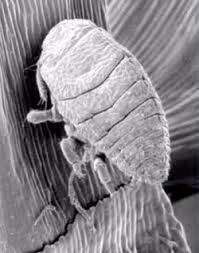ManageSafe™
Least-Toxic Control of Hemlock Woolly Adelgid Choose a different pests

|
Factsheet: Least toxic control of Hemlock Woolly Adelgid
Identification
Pest type: Insects
The hemlock woolly adelgid (HWA) is a small, aphid-like insect with piercing-sucking mouthparts, which are used to suck sap from plants. For most of its life, it is covered by a white wooly substance that it secretes all over its body. They feed primarily on young branches, causing cessation of tree growth, discoloration and premature drop of needles, the dieback of branches and possible death of the tree in as little as one year.
Eastern hemlock ranges stretch south form Nova Scotia to Northern Alabama and west to northeastern Minnesota and eastern Kentucky. Carolina hemlock ranges extend from southern West Virginia down the east coast to Georgia.
The females are oval, blackish-grey, about 2mm in length and serve as the overwintering stage. The brownish-orange, very small, oblong eggs are laid in cottony white egg sacs (about 50 eggs per sac) on young twigs from late March to May. The presence of the egg sacs offers the most visible diagnostic evidence of infestation. The eggs hatch into reddish-brown crawlers (nymphs) from early April through early June and begin feeding on the sap of young twigs, maturing into adults in a few weeks. Some of the adults are wingless and remain on hemlock for a second generation, while the winged forms may fly to nearby hemlocks or spruces.
Is it a problem?
In eastern North America, it is a destructive pest that gravely threatens the eastern hemlock and the Carolina hemlock.
Pest prevention practices
Foster natural resilience
Do not disturb shallow roots with heavy equipment or by digging or tilling.
Keep hemlocks well-watered (apply about 1 inch / week around drip line) during droughts.
In-Depth Information:
Don't place bird feeders among your hemlock trees in infested areas of your state, as birds can transport HWA crawlers to your trees. Heavily infested trees can act as resevoirs for uninfested trees, so be sure to remove them as soon as possible. If you can catch the infestation early enough, this may significantly slow the insect's spread and build-up.
Monitoring and record-keeping
Infestations can be detected early by periodically examining young twigs for the presence of the egg sacs and the presence of a white cottony scale on the hemlock branches. Egg sacs are readily observed in the spring before the eggs have hatched. Keep in mind that remnants of old egg sacs may remain on twigs long after the eggs have hatched and the insect has been controlled. Early detection is very important because injury to hemlock may develop quickly.
Non-chemical and mechanical controls
Remove debris and habitat
In-Depth Information:
Do not apply nitrogen fertilizer to trees infested with HWA. Researchers have found five times as many HWAs on nitrogen-fertilized trees, regardless of whether fertilization occurred at infestation or six months later. If control measures fail, affected areas can be replanted with native speicies, such as eastern white pine, that are similar ecologically but are not affected by HWA.
Biological controls
Proper timing is key for control of HWA:
- Pseudoscymnus tsugae (PT) is a pinhead-sized, specialized, black lady beetle discovered feeding on HWA in Japan in 1992. Having completed several years of successful tests in cooperation with the U. S. Forest Service, in 1999 the Pennsylvania Department of Conservation and Natural Resources’ (DCNR) Bureau of Forestry started a statewide PT release project in Pennsylvania.
- Laricobius nigrinus (LN) is a beetle that is native to the western North America where it preys on HWA on western hemlock. Laricobius beetles only feed on woolly adelgids. LN adults lay eggs in early spring on over wintering HWA nymphs. Larvae emerge and feed on HWA until they mature in spring, when they enter the soil to pupate.
- In a field study conducted in Massachusetts during 2002 and 2003 HWA populations were significantly reduced by a single fall application of fungi, V. lecanii. A second fungi, B. bassiana, was also efficient when applied using a ultra-low volume (ULV) sprayer. Spring applications were not as effective. Fungus applications also had did not cause any significant decrease in survival rate of beneficial insects
Least-toxic chemical options as a last resort
Horticultural oils and insecticidal soaps have shown to be very effective when sprayed during susceptible life stages. 100% mortality was obtained by both materials when sprayed in mid-July (when all individuals were present as dormant nymphs) and in late October (after the nymphs had resumed development).
Chemicals to Avoid
Look at your product labels and try to avoid products containing those chemicals listed below:
(A = acute health effects, C = chronic health effects, SW = surface water contaminant, GW = ground water contaminant, W = wildlife poison, B = bee poison, LT = long-range transport)
|
Bifenthrin Deltamethrin | Dinotefuran Imidacloprid | Permethrin |
Social Media
See what other folks are saying about this, and let us know what works for you.
Hemlock Woolly Adelgid (HWA): Welcome Back to Question of the Week!Question:There is a hemlock tree that is on the...
Posted by Beyond Pesticides on Friday, April 1, 2016
Click the post above to view and comment on Facebook, or comment directly on this site below.








